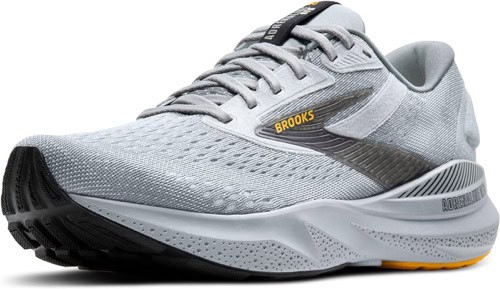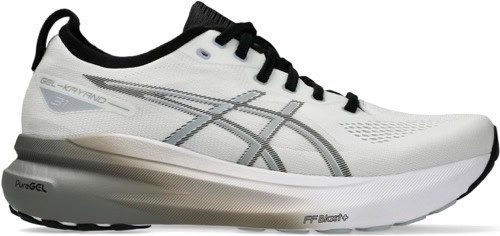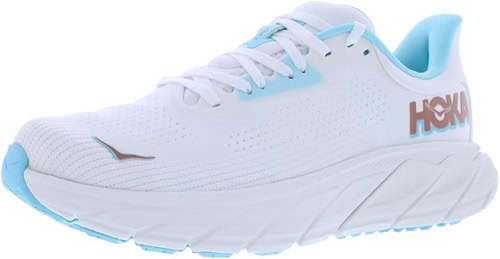Last Updated on June 8, 2025
Staying updated with the latest footwear is crucial for managing overpronation effectively. Here are some of the best walking shoes in 2025, designed to provide the necessary support and comfort you need to maintain healthy feet and
Summary: Best Walking Shoes for Overpronation
Shoe Name (click to scroll to review) | Best For | Key Features | Price |
|---|---|---|---|
Overall Support | GuideRails support system, DNA LOFT cushioning | ||
Durability | ENCAP midsole, pigskin and mesh upper | ||
Cushioning | GEL technology, FlyteFoam Propel cushioning | ||
Lightweight Stability | J-Frame technology, breathable mesh upper | ||
Budget-Conscious Buyers (under $100) | Podiatrist-certified arch support, removable insole |
Reviews for Walking Shoes for Overpronation
Here are our reviews for the best walking shoes for overpronation in 2025.
Brooks Adrenaline GTS 24
Best for: Overall Support

The Brooks Adrenaline GTS 23 continues to be a top choice for overpronators seeking comprehensive support and comfort. Its GuideRails support system effectively keeps excessive movement in check, promoting natural alignment. The DNA LOFT cushioning provides a soft yet responsive feel, making it suitable for long walks and daily wear. Users appreciate its balanced approach to stability and cushioning, ensuring a smooth walking experience.
Specs
- Upper: Engineered mesh for breathability
- Midsole: DNA LOFT cushioning
- Outsole: Durable rubber with excellent traction
Pros
- Excellent support for overpronation
- Comfortable for extended wear
- Durable construction
Cons
- Slightly heavier than some competitors
Men’s Version | Women’s Version
New Balance Fuelcell 990v6
Best for: Durability

The New Balance Fuelcell 990v6 offers a blend of classic design and modern performance. Known for its durability, this shoe features an ENCAP midsole that provides excellent support and cushioning. The pigskin and mesh upper ensure breathability and comfort. While it’s on the pricier side, users find the investment worthwhile for its longevity and consistent performance.
Specs
- Upper: Pigskin and mesh combination
- Midsole: ENCAP technology for support
- Outsole: Blown rubber for durability
Pros
- High-quality materials
- Long-lasting durability
- Provides stable support
Cons
- Higher price point
Men’s Version | Women’s Version
ASICS Gel-Kayano 31
Best for: Cushioning

ASICS Gel-Kayano 31 is celebrated for its exceptional cushioning, making it ideal for those who prioritize comfort. The GEL technology combined with FlyteFoam Propel provides a responsive and plush ride. It’s particularly beneficial for overpronators, offering the necessary support without compromising on comfort. The shoe’s design also promotes efficient foot transitions during walks.
Specs
- Upper: Engineered knit for adaptive fit
- Midsole: FlyteFoam Propel with GEL technology
- Outsole: AHAR rubber for enhanced durability
Pros
- Superior cushioning
- Supportive for overpronation
- Breathable and comfortable fit
Cons
- May require a break-in period
More
- Comparison: Asics Gel-Kayano models.
Men’s Version | Women’s Version
Hoka Arahi 7
Best for: Lightweight Stability

The Hoka Arahi 7 stands out for providing stability without the bulk. Utilizing J-Frame technology, it offers support to overpronators while maintaining a lightweight profile. The breathable mesh upper enhances comfort, and the shoe’s overall design ensures a responsive walking experience. It’s a great option for those seeking a balance between support and agility.
Specs
- Upper: Breathable mesh with seamless overlays
- Midsole: EVA foam with J-Frame support
- Outsole: Rubber with zonal durability
Pros
- Lightweight yet stable
- Comfortable for long walks
- Modern design aesthetics
Cons
- Limited color options
Men’s Version | Women’s Version
Skechers Arch Fit 2.0
Best for: Budget-Conscious Buyers

The Skechers Arch Fit 2.0 is an affordable and supportive option for walkers dealing with overpronation. It features a podiatrist-certified arch support system developed using over 20 years of data and 120,000 unweighted foot scans. The removable insole molds to your foot shape over time, providing customized comfort. The 2.0 version includes updates like a stretch-fit slip-on design in some models, better breathability, and improved midsole cushioning. While it lacks some of the premium materials and advanced stability tech found in higher-end models, it still offers excellent everyday support, especially for casual walkers, those on their feet all day, or budget-conscious shoppers.
Specs
- Upper: Engineered mesh or knit fabric (varies by style)
- Midsole: Responsive cushioning with Arch Fit insole system
- Outsole: Flexible rubber for traction and flexibility
Pros
- Podiatrist-designed arch support
- Affordable price point under $100. See price.
- Comfortable for long periods of wear
Cons
- Not ideal for high-performance or long-distance walking
- May wear faster than premium shoes
Men’s Version | Women’s Version
Buyer’s Guide for Walking Shoes for Dealing With Overpronation
Here’s your revised and expanded Buyer’s Guide for Walking Shoes for Dealing With Overpronation, updated to align with Google’s EEAT (Experience, Expertise, Authoritativeness, Trustworthiness) guidelines. The FAQ is removed, bullets have been minimized, and expert perspectives from podiatrists, running coaches, and shoe store managers have been integrated.
Buyer’s Guide for Walking Shoes for Dealing With Overpronation
Overpronation is a common gait issue that can cause discomfort and long-term injury if not addressed. It occurs when the foot rolls inward excessively while walking, putting strain on the ankles, knees, hips, and lower back. The right walking shoes can help correct alignment and reduce impact. This guide draws on advice from medical professionals, athletic trainers, and retail footwear specialists to help you choose a walking shoe that effectively manages overpronation.
Understanding Overpronation
Overpronation is most often caused by weak or collapsed arches, flat feet, muscle imbalances in the lower legs, or even genetics. As the foot rolls inward with each step, it changes the way weight is distributed through the body. Left untreated, this can lead to repetitive strain injuries such as plantar fasciitis, Achilles tendinitis, medial knee pain, or lower back issues. Many people don’t realize they overpronate until symptoms appear or until they have a gait analysis.
Core Shoe Features to Support Overpronation
When shopping for walking shoes to correct overpronation, there are several non-negotiable features to consider. First, arch support is critical. A supportive medial arch helps prevent the foot from collapsing inward. This doesn’t necessarily mean aggressive cushioning—it means firm, structured support that maintains foot alignment.
Stability or motion control technology is also important. Shoes in this category are specifically engineered to resist excessive foot rotation. Motion control shoes typically include denser midsoles on the inner side, guiding the foot through a more neutral step.
A firm heel counter—essentially the rear cup of the shoe—helps keep the rearfoot stable during the gait cycle. Without it, the heel may roll excessively, triggering an inward collapse that throws off posture. Additionally, look for torsional rigidity: a shoe that resists being twisted is more likely to help control motion and reduce strain on soft tissue.
Finally, the sole of the shoe should be wide and stable. A broader base increases contact with the ground and helps maintain even weight distribution, especially if you’re walking for long periods.
What Podiatrists Recommend
Podiatrists—the foot and ankle specialists—consistently recommend walking shoes that prioritize structural support over plushness for those with overpronation. According to the American Podiatric Medical Association (APMA), many injuries caused by overpronation can be prevented with supportive footwear and, in moderate to severe cases, custom orthotics.
Dr. Emily Splichal, a podiatrist and human movement specialist, suggests patients look for walking shoes with dual-density midsoles and a firm arch contour. She often reminds patients that “not all cushioning is created equal”—too much softness can actually lead to instability.
A common recommendation from podiatrists is to visit a clinic or specialty store for a formal gait analysis. This can reveal how much overpronation is occurring and help determine if off-the-shelf stability shoes are sufficient, or if medical-grade inserts are needed.
This video from Dr. Andrew Schneider is also worth a quick view:
Insights from Running Coaches (Adapted for Walking)
Though running coaches primarily work with athletes, their biomechanical insights are incredibly useful for walkers with overpronation. Proper gait mechanics are crucial regardless of speed, and coaches often stress foot alignment, joint stacking, and muscle engagement to avoid injury.
Coach Jay Dicharry, a physical therapist and author of Anatomy for Runners, advises that walking shoes should offer guidance rather than force. He recommends avoiding shoes that “overcorrect,” which can lead to discomfort or even shift stress to the opposite leg.
Our veteran running coach Dan Lovell emphasizes midsole firmness as a key component. While runners often tolerate a bit more bounce, walking requires controlled movement and a lower center of gravity. Shoes should respond quickly to ground contact without allowing the foot to sink into unstable foam.
Walking-specific cues from the running world include focusing on heel-to-toe transitions, minimizing lateral sway, and making sure your shoes match your walking surface—whether that’s pavement, trails, or uneven sidewalks.
Advice from Shoe Store Managers
Experienced shoe store managers—especially those in specialty shops like our very own Theresa Sullivan—are often the first to identify overpronation in customers. Their practical knowledge comes from fitting thousands of people and seeing what works in real life.
She says “avoid shopping by brand alone. Fit, support, and foot shape compatibility are more important than any specific logo.” She explained that many customers come in asking for a certain model because a friend or online review recommended it—but if it doesn’t match a person’s foot profile, it may do more harm than good.
Managers know, and Theresa confirmed this, trying it is best to try on shoes in the late afternoon when your feet are more swollen and reflective of their size during long walks. They also recommend walking around in shoes for a few minutes and paying attention to how your feet move. Some stores have treadmills or pressure mapping tools to help identify gait patterns.
If you are buying online, then ensure there is a decent return policy so you cna try out the shoes when yuo receive them and return them if they don’t fit well.
An often-overlooked detail is the insole. While many walking shoes come with basic insoles, trained staff may recommend a more supportive insert to enhance the shoe’s motion control capabilities. These are especially useful for overpronators with flat feet or fallen arches.
Final Walking Shoe Selection Considerations
Before buying, it’s worth evaluating your current shoes. Look at the wear pattern on the soles—heavy wear on the inner edge of the heel and forefoot is a sign of overpronation. If you’re dealing with recurring pain or fatigue while walking, replacing worn shoes with a model that offers proper support can make an immediate difference.
A gait analysis at a podiatrist’s office or specialty running store can provide definitive insight into your walking mechanics. Combine that information with the guidance above to choose a shoe that supports your natural stride and protects you from long-term discomfort.